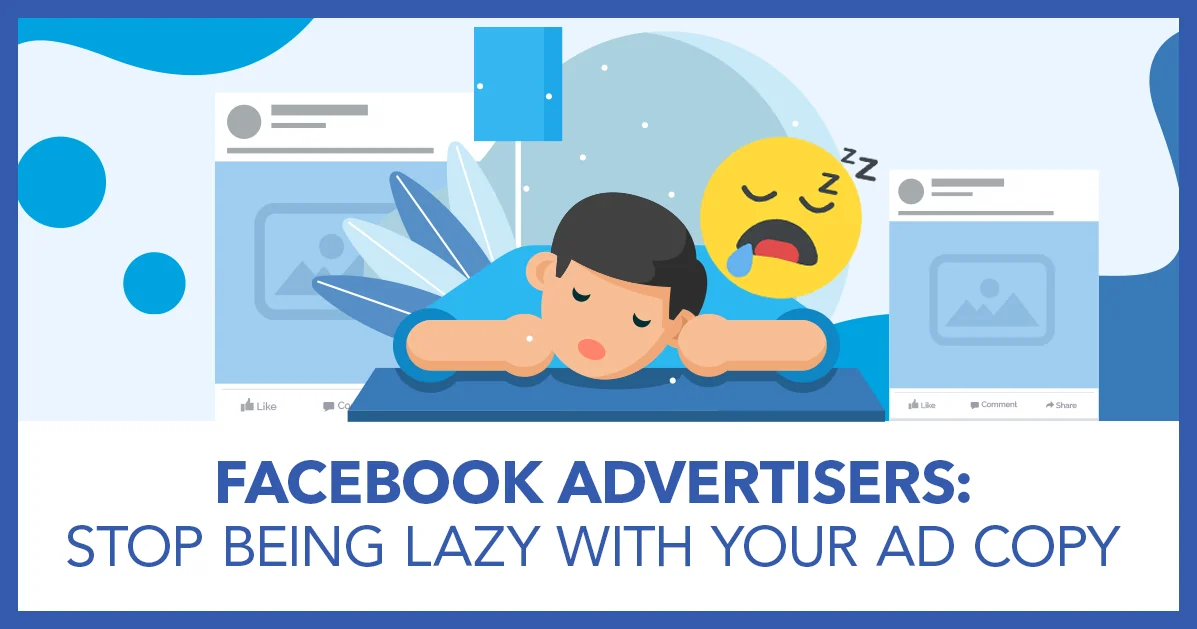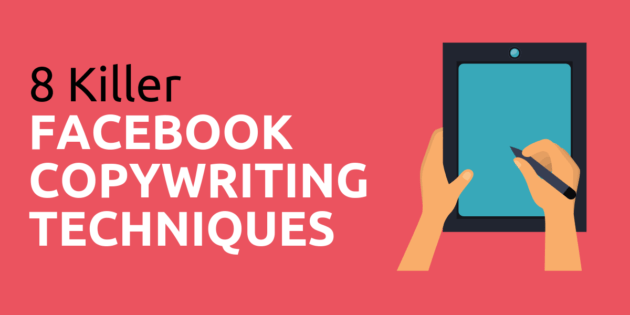
8 Facebook Copywriting Techniques To Create Killer Facebook Ads
Looking to improve your Facebook ad copy? In this article, I’ve included 8 of my favourite Facebook copywriting techniques.
But how important are Facebook copywriting techniques? Well, Facebook currently boasts approximately 2.38 active monthly users. Advertising on the platform is clearly an easy way to reach a large number of potential leads.
And you’re far more likely to turn those prospects into paying customers if you optimise your Facebook ad copy.
These tips will help. Keep them in mind, and your copy will deliver results!
#1 Focus on One Call-to-Action
You should always know what your specific goals are when writing a Facebook ad.
Determine if you want the ad to attract more followers, generate conversions, boost website traffic, or anything else you wish to achieve.
This helps you write the strongest possible CTA. Your CTA should align with your goal.
You don’t want to lose focus when writing Facebook ad copy. It’s much easier to maximize your return-on-investment when you know exactly what type of action you want users to take after seeing your ad.
For example, perhaps you want to attract more subscribers to your email list. A relevant CTA might be something along the lines of “Sign up now!”
It may be simple, but that’s the point. A basic CTA that focuses on one clear goal is more effective than a CTA that’s too vague.
It’s also important that your CTA be relatively noticeable. Consider the following example:
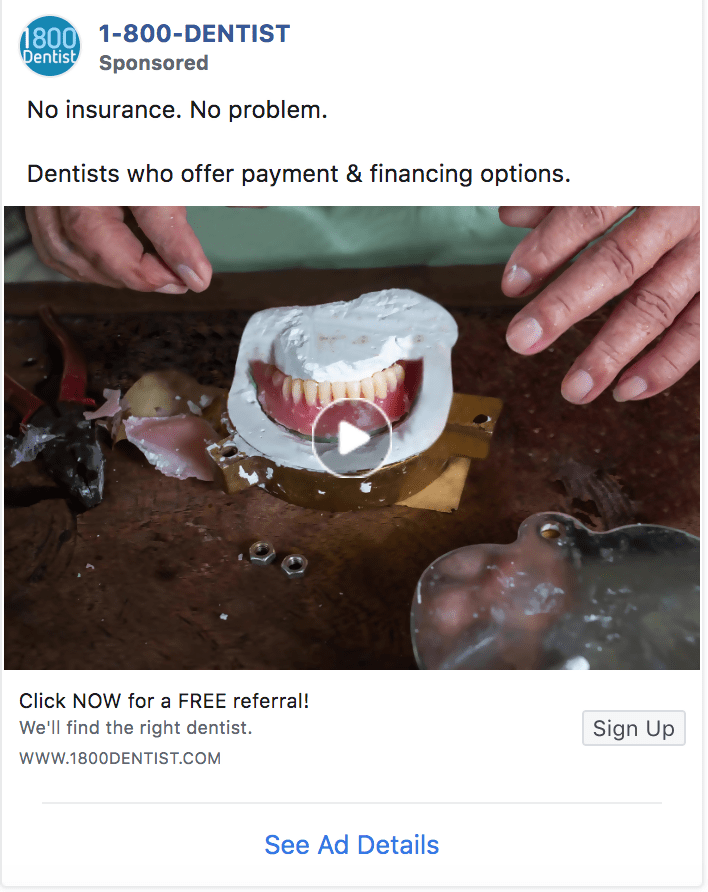
Here they’ve converted the entire headline into a call-to-action. They couldn’t have made it much more prominent.
#2 Test Different Versions of Your Facebook Ad Copy
Coming up with killer Facebook ad copy is much easier when you test different options. Luckily, Facebook makes this easy with split testing.
Start by creating (or editing) a campaign and choosing your objective. Perhaps you want to boost brand awareness:
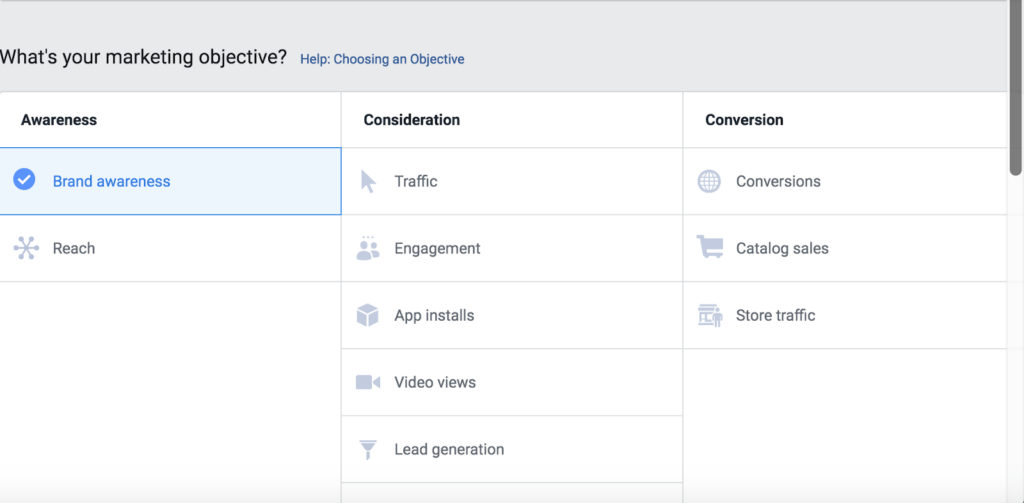
Once you’ve selected your objective, scroll down and turn on Create Split Test.
Choose “Creative” as your variable in the “What do you want to test?” field, then select Continue.
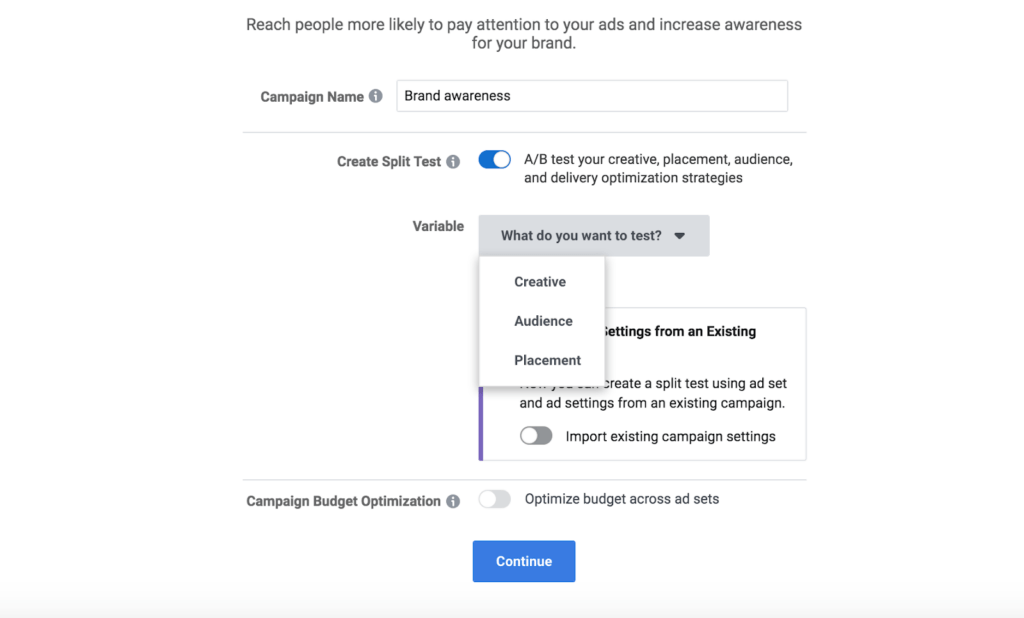
Now you can choose a duration and budget for your split test. You can also select which audiences you want to target before creating your ads.
Make sure you pay attention to your goals when comparing the performance of different types of copy. For instance, if your goal is to generate conversions, you want to determine which copy is most effective at achieving that goal.
(To do this effectively you will need to have the Facebook Pixel installed on your website. This video shows you how…)
Once you know which Facebook ad copy variation is performing best, you can determine why. Maybe the tone is friendlier, the copy is shorter, the CTA is more focused, etc.
This is an extremely valuable Facebook copywriting technique! It helps you make major improvements to your copy without spending a fortune.
#3 Keep Facebook Copywriting Simple
You want your ads to appeal to as many users as possible. That involves making sure the language isn’t too complex for some readers.
Don’t think of Facebook ads as literature. They should clearly and simply explain their value to a user.
Consider the following example that Facebook provide:
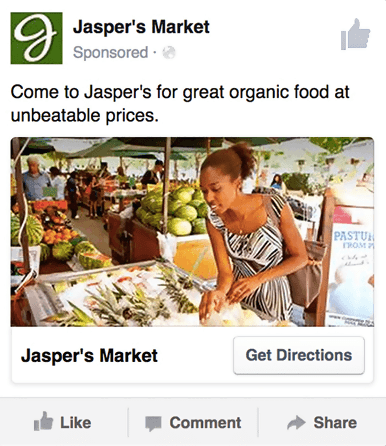
It’s very to-the-point. The copy tells a user what action they should take (“Come to Jasper’s”) and explains why they should take that action (“great organic food at unbeatable prices.”)
Few users would have difficulty reading this ad copy. If possible, yours should be equally simple.
#4 Know Your Audience
Knowing who you are targeting is another smart way to improve your Facebook ads. Once again, this relates to knowing what your goals are.
Is your goal to boost brand awareness among new potential leads? If so, your Facebook ad copy should introduce them both to your brand’s identity, and to the general benefits your products or services offer.
Ads targeting existing customers or followers should be written differently. An ad announcing a loyalty program for long-time customers (something which appeals to 72% of consumers) should feature copy that addresses the fact that they know your brand.
For example, an ad spreading brand awareness among new leads might feature Facebook copywriting such as:
“Try [product name] to [general benefits]!”
An ad letting existing followers know about a loyalty program might include such copy as:
“Earn discounts and special offers by joining our loyalty program. It’s our gift to you.”
Again, when you know who your audience is, you’ll know how to address them.
There are also instances when it’s smart to begin your ad by addressing the audience. Consider the following example:

This ad is promoting a special discount Walt Disney World ticket that’s only available to Florida residents. So, the copy begins by clearly stating this.
A less effective version of this ad would include this information later in the copy, failing to grab the attention of those it’s targeting.
This in fact leads directly to our next important point…
#5 Put Important Information First
Facebook users are easily distracted. There is simply too much content on the platform for them to engage with.
That’s why your ad copy needs to grab their attention by immediately focusing on the benefits they would enjoy from taking a certain action.
Perhaps you’re marketing an apparel brand and wish to announce a sale on winter gear. You could write such copy as:
“Winter is almost here! Get ready by heading to our site to check out all the great winter items currently on sale!”
However, this would be a mistake, as you’re not starting off with a value proposition. Stronger copy might be:
“Save up to 50% on winter gear! Visit our site and get ready for the season now!”
You’ve immediately hooked a user’s attention. That should be your goal.
#6 Keep Your Facebook Ad Copy Organized
Keeping your copy short and simple is often a good idea. That said, there may be instances when you have a lot of information to share.
When this happens, use short paragraphs and bullet points to ensure your copy stays organised.
This is particularly important now that mobile browsing is more popular than desktop browsing. Your copy should be easy to read on a mobile device.
For example, let’s return to the winter sale scenario. You don’t want your Facebook copywriting to look like this:
“Save up to 50% on winter gear! Visit our site and get ready for the season now! Save on ski jackets, boots, gloves, snow pants, winter hats, winter socks, and much more!”
This copy would be easier to read with bullet points, as shown below:
“Save up to 50% on winter gear! Visit our site to save on:
- Ski Jackets!
- Boots!
- Gloves!
- Snow Pants!
- Winter Hats!
- Winter Socks!
- So much more!”
Notice how each item stands out more in the second example? Keep that in mind when writing your copy.
It’s also worth noting that you may be able to clean up the copy by following Best Buy’s approach, as depicted here:
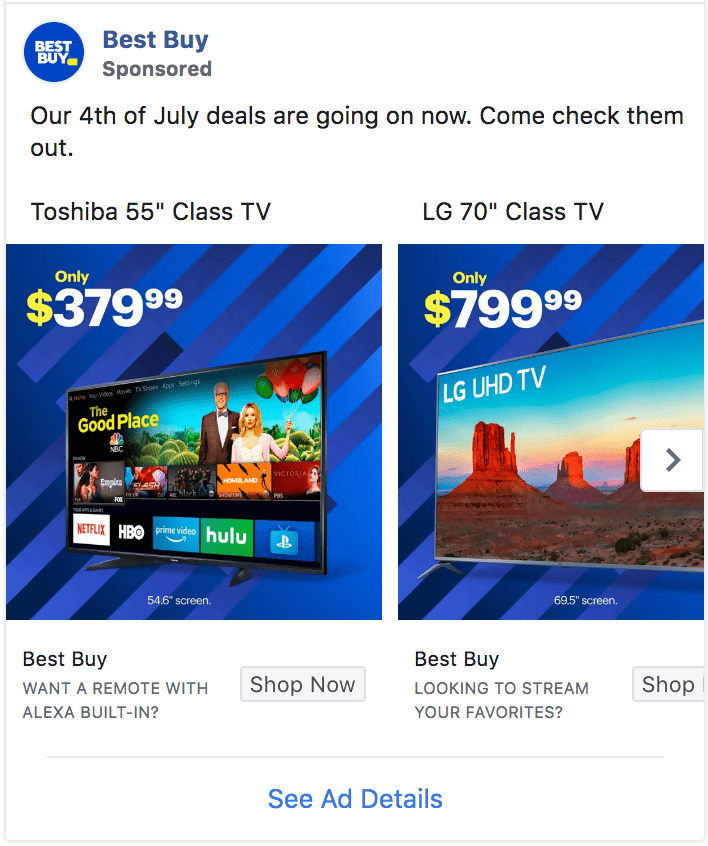
This Facebook ad’s copy is to-the-the-point. It starts with important information, segues directly to a CTA, and lets users browse a selection of items instead of listing them all in the copy itself.
This simplifies the ad and gives users the opportunity to engage with it directly instead of passively consuming it.
#7 Match Your Brand’s Identity
Facebook ads contribute to users’ impression of your brand. Therefore, your copy needs to match your branding.
Perhaps your branded identity is friendly and enthusiastic. Your Facebook ad copy should therefore be appropriately conversational.
On the other hand, maybe you’re marketing a more serious organisation, such as a law firm. In that case, you would want to use formal language when writing copy.
The point is that there is no single “right” type of language for all brands. You need to determine what kind of language aligns with yours.
For instance, here’s an example from a law firm:

While it’s understandable that a lawyer may want to promote their appearance on a TV program, the way in which they do so here doesn’t match the brand one would expect from such a professional.
The language is too casual, and the copy contains basic grammatical errors.
This could give prospects the impression that the person sharing this content doesn’t run the kind of serious organisation they would look for when hiring an attorney.
#7 Create Urgency with Your Facebook Copy
Creating a sense of urgency is a great Facebook copywriting technique.
People are more likely to take action when they know they only have limited opportunities to take advantage of certain deals or promotions.
Luckily, creating a sense of urgency can be very easy.
Is your ad letting customers know about a current sale? Use such language as “Act now!” or “Sale ends [date]!” to encourage action.
Or, perhaps you’re announcing a new product you expect to sell out quickly. Your copy could include such language as “Supplies are limited.”
Someone who might otherwise wait to click on your ad will now be more inclined to act.
You should always look for ways to make copy naturally feel more urgent. For instance, consider this example from popular retailer Target:
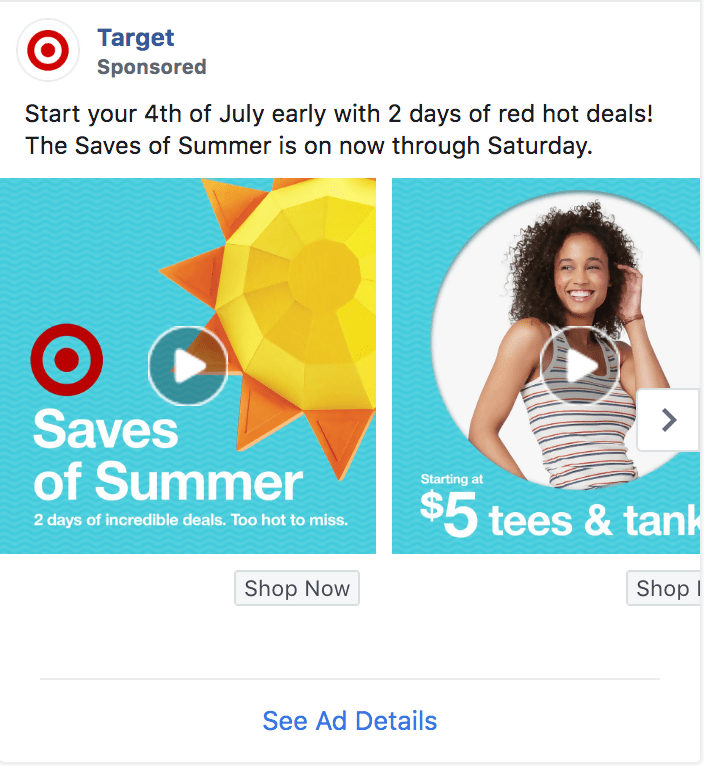
The ad is promoting a brief sale. While it does make this clear, it could be more effective if the copy started with “Two days only!” or similar wording.
Of course, it’s also important to monitor your ads’ performance. By following these tips and paying attention to which strategies work, you’ll find it’s much easier to write Facebook ad copy that works.
What do you think? Which Facebook copywriting technique are you going to use first? Let me know in the comments below…



